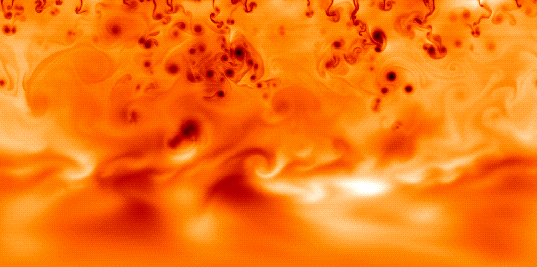The "Boiling" Zone

Once out of the radiation zone the energy, originally produced in the
core, requires a new transport mechanism to continue its journey to the
surface. This new method of transport is required because outside of the
radiation zone the temperature is relatively cool, now only 2
million degrees Kelvin as opposed to 5 million in the radiation zone.
At this temperature the atoms in will absorb energy, but because things are
cool and dense the atoms do not release it so readily.
Consequently the transfer of energy by radiation slows down
significantly.
We now need another method to transport the Sun's energy to the surface.
 The most efficient means of energy transfer is now convection and we
find ourselves in the region of the Sun's interior know as the convection
zone. The hotter
material near the top of the radiation zone (the bottom of the convection
zone) rises up and the cooler material sinks to the bottom. As the hot
material reaches the top of the convection zone it begins to cool and sink,
and as it sinks it heats up again and will rise.
This produces a rolling motion much like that in a pot of boiling water.
The most efficient means of energy transfer is now convection and we
find ourselves in the region of the Sun's interior know as the convection
zone. The hotter
material near the top of the radiation zone (the bottom of the convection
zone) rises up and the cooler material sinks to the bottom. As the hot
material reaches the top of the convection zone it begins to cool and sink,
and as it sinks it heats up again and will rise.
This produces a rolling motion much like that in a pot of boiling water.
The hot material follows a direct path through the convective zone and the
energy is transferred much faster than it is by radiation. It takes only a
little more than a week for the hot material to carry its energy to the top
of the convection zone.

Photosphere
Structure Menu
 The most efficient means of energy transfer is now convection and we
find ourselves in the region of the Sun's interior know as the convection
zone. The hotter
material near the top of the radiation zone (the bottom of the convection
zone) rises up and the cooler material sinks to the bottom. As the hot
material reaches the top of the convection zone it begins to cool and sink,
and as it sinks it heats up again and will rise.
This produces a rolling motion much like that in a pot of boiling water.
The most efficient means of energy transfer is now convection and we
find ourselves in the region of the Sun's interior know as the convection
zone. The hotter
material near the top of the radiation zone (the bottom of the convection
zone) rises up and the cooler material sinks to the bottom. As the hot
material reaches the top of the convection zone it begins to cool and sink,
and as it sinks it heats up again and will rise.
This produces a rolling motion much like that in a pot of boiling water. 